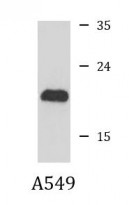ARG57366
anti-MHF1 antibody
anti-MHF1 antibody for Western blot and Human
Overview
| Product Description | Rabbit Polyclonal antibody recognizes MHF1 |
|---|---|
| Tested Reactivity | Hu |
| Tested Application | WB |
| Host | Rabbit |
| Clonality | Polyclonal |
| Isotype | IgG |
| Target Name | MHF1 |
| Antigen Species | Human |
| Immunogen | Recombinant Protein of Human MHF1. |
| Conjugation | Un-conjugated |
| Alternate Names | MHF1; APITD1; CENP-S; FAAP16 |
Application Instructions
| Application Suggestion |
|
||||
|---|---|---|---|---|---|
| Application Note | * The dilutions indicate recommended starting dilutions and the optimal dilutions or concentrations should be determined by the scientist. | ||||
| Positive Control | A549 |
Properties
| Form | Liquid |
|---|---|
| Purification | Affinity purification with immunogen. |
| Buffer | PBS (pH 7.3), 0.02% Sodium azide and 50% Glycerol. |
| Preservative | 0.02% Sodium azide |
| Stabilizer | 50% Glycerol |
| Storage Instruction | For continuous use, store undiluted antibody at 2-8°C for up to a week. For long-term storage, aliquot and store at -20°C. Storage in frost free freezers is not recommended. Avoid repeated freeze/thaw cycles. Suggest spin the vial prior to opening. The antibody solution should be gently mixed before use. |
| Note | For laboratory research only, not for drug, diagnostic or other use. |
Bioinformation
| Database Links | |
|---|---|
| Gene Symbol | CENPS |
| Gene Full Name | centromere protein S |
| Background | This gene was identified in the neuroblastoma tumor suppressor candidate region on chromosome 1p36. It contains a TFIID-31 domain, similar to that found in TATA box-binding protein-associated factor, TAF(II)31, which is required for p53-mediated transcription activation. This gene was expressed at very low levels in neuroblastoma tumors, and was shown to reduce cell growth in neuroblastoma cells, suggesting that it may have a role in a cell death pathway. The protein is a component of multiple complexes, including the Fanconi anemia (FA) core complex, the APITD1/CENPS complex, and the CENPA-CAD (nucleosome distal) complex. Known functions include an involvement with chromatin associations of the FA core complex, and a role in the stable assembly of the outer kinetochore. Alternative splicing of this gene results in multiple transcript variants. Naturally occurring read-through transcripts also exist between this gene and the downstream cortistatin (CORT) gene, as represented in GeneID:100526739. An APITD1-related pseudogene has been identified on chromosome 7. [provided by RefSeq, Nov 2010] |
| Function | DNA-binding component of the Fanconi anemia (FA) core complex. Required for the normal activation of the FA pathway, leading to monoubiquitination of the FANCI-FANCD2 complex in response to DNA damage, cellular resistance to DNA cross-linking drugs, and prevention of chromosomal breakage (PubMed:20347428, PubMed:20347429). In complex with CENPX (MHF heterodimer), crucial cofactor for FANCM in both binding and ATP-dependent remodeling of DNA. Stabilizes FANCM (PubMed:20347428, PubMed:20347429). In complex with CENPX and FANCM (but not other FANC proteins), rapidly recruited to blocked forks and promotes gene conversion at blocked replication forks (PubMed:20347428). In complex with CENPT, CENPW and CENPX (CENP-T-W-S-X heterotetramer), involved in the formation of a functional kinetochore outer plate, which is essential for kinetochore-microtubule attachment and faithful mitotic progression (PubMed:19620631). As a component of MHF and CENP-T-W-S-X complexes, binds DNA and bends it to form a nucleosome-like structure (PubMed:20347428, PubMed:22304917). DNA-binding function is fulfilled in the presence of CENPX, with the following preference for DNA substates: Holliday junction > double-stranded > splay arm > single-stranded. Does not bind DNA on its own (PubMed:20347428, PubMed:20347429). [UniProt] |
| Calculated MW | 16 kDa |
Images (1) Click the Picture to Zoom In






